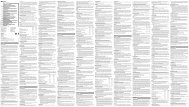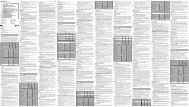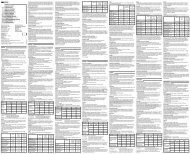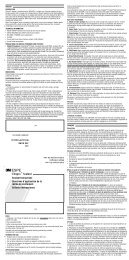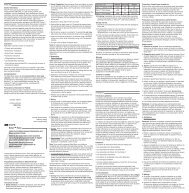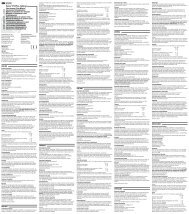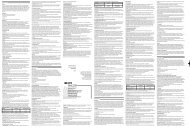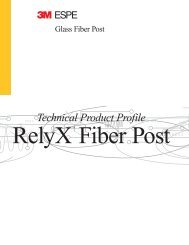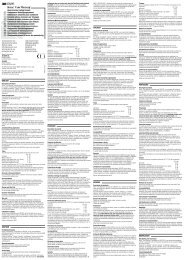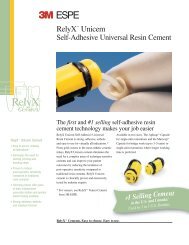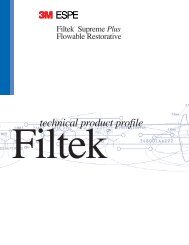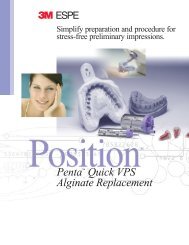RelyX⢠ARC Adhesive Resin Cement - Dale Dental
RelyX⢠ARC Adhesive Resin Cement - Dale Dental
RelyX⢠ARC Adhesive Resin Cement - Dale Dental
Create successful ePaper yourself
Turn your PDF publications into a flip-book with our unique Google optimized e-Paper software.
Properties<br />
11<br />
A variety of physical property testing was performed on 3M RelyX <strong>ARC</strong> <strong>Adhesive</strong><br />
<strong>Resin</strong> <strong>Cement</strong>. Currently, there is no specification that regulates resin cements. There is<br />
a new ISO 4049 specification under proposal for the resin cement category. At this time,<br />
the ISO specification has not been issued but is in the final draft form and can be identified<br />
as ISO/DIS 4049:1998. The proposed standard will include tests such as film thickness,<br />
flexural strength, solubility, water sorption, work and set time, and if claimed by<br />
the product, radiopacity and color stability. Some of the data from the test standard will<br />
be referenced in the properties sections and additional data will follow when the standard<br />
issues. Internal test method data is provided for adhesion, wear resistance, compressive<br />
and diametral tensile strengths in both the light-cure and self-cure mode and viscosity vs.<br />
shear rate.<br />
Bond Strength Testing<br />
Shear bond strength tests were conducted to simulate the conditions of bonding indirect<br />
restorations and amalgam to tooth structure and various core build-up materials. Bonding<br />
was conducted by adhering cylinders of the test materials (metal, amalgam, porcelain, or<br />
precured composite) to polished enamel, dentin, metals, set amalgam, composite and GI<br />
core build up materials that were embedded in acrylic plugs. All testing was conducted<br />
with the 3M Single Bond <strong>Adhesive</strong> being light-cured and RelyX <strong>ARC</strong> resin cement<br />
allowed to self-cure. Porcelain surfaces were etched using hydrofluoric acid and then silanetreated<br />
with 3M RelyX ceramic primer. Metal surfaces were abraded using 50 grit aluminum<br />
oxide. Composite samples were fabricated using 3M Restorative Z-100 which was<br />
precured for 40 seconds and then abraded with 320 silicon carbide to yield a flat bonding<br />
surface.<br />
Bond values obtained for several indirect and amalgam bonding systems are presented<br />
in Figures 2-16. 3M Scotchbond <strong>Resin</strong> <strong>Cement</strong> with 3M Scotchbond Multi-<br />
Purpose Plus (SBRC/SBMP+) <strong>Adhesive</strong> was tested as a control with the RelyX <strong>ARC</strong><br />
resin cement system. The shear bond strength tests indicate that RelyX <strong>ARC</strong> resin cement<br />
provides high bond strengths to a variety of substrates with a variety of indirect materials.<br />
All shear bond strength values were determined from a sample size of 10 for each combination<br />
tested. The compositions of the various components used in the adhesion testing<br />
are as follows:<br />
• High Noble Metal: 62% Gold, 3% Palladium, 9% Copper, 25% Silver<br />
• Noble Metal: 80% Palladium, 2-5% Gold, 1.5% Silver<br />
• Base Metal: 74-78% Nickel, 12-15% Chromium, 4-6% Molybdenum,<br />
1.8% Beryllium<br />
• Porcelain: Crystar®, Vintage Body A3<br />
• Composite: 3M Z-100 Restorative<br />
• Amalgam: Tytin®, Dispersalloy®



